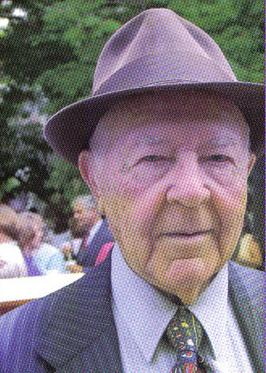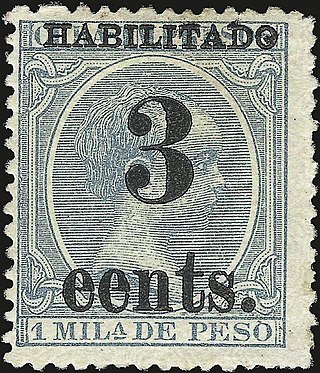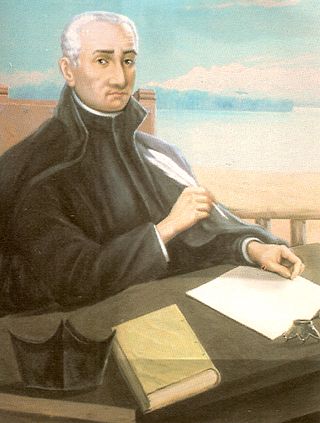
Philatelic literature is written material relating to philately, primarily information about postage stamps and postal history.

The Bolivarian Republic of Venezuela is a federation made up of twenty-three states, a Capital District and the Federal Dependencies, which consist of many islands and islets in the Caribbean Sea. Venezuela claims the disputed Essequibo territory as one of its states, which it calls Guayana Esequiba, but the territory is controlled by Guyana as part of six of its regions.

Essequibo was a Dutch colony in the Guianas and later a county on the Essequibo River in the Guiana region on the north coast of South America. It was a colony of the Dutch West India Company between 1616 and 1792 and a colony of the Dutch state from 1792 until 1815. It was merged with Demerara in 1812 by the British who took control. It formally became a British colony in 1815 until Demerara-Essequibo was merged with Berbice to form the colony of British Guiana in 1831. In 1838, it became a county of British Guiana till 1958. In 1966, British Guiana gained independence as Guyana and in 1970 it became a republic as the Co-operative Republic of Guyana. It was located around the lower course of the Essequibo River.
Francisco Eppens Helguera was a Mexican artist known for his paintings, murals and sculptures of images and scenes distinctly Mexican. He also achieved international fame for his award winning modern designs for Mexican postage and revenue stamps (1935–1953) and for his 1968 redesign of the Mexican coat of arms, still used today on Mexican government documents, coins and the national flag.
Venezuelan literature is the literature written by Venezuelans or in Venezuela, ranging from indigenous pre-Hispanic myths to oral or written works in Spanish or other languages. The origins of Venezuelan written literature are usually held to date back to the documents written by the first Spanish colonizers, its date of birth being sometimes set at August 31, 1498, when Christopher Columbus called the Venezuelan territory in his Diaries "Tierra de gracia".

This is a survey of the postage stamps and postal history of Cuba.

The Guyana–Venezuela territorial dispute is an ongoing territorial dispute between Guyana and Venezuela over the Essequibo region, also known as Esequibo or Guayana Esequiba in Spanish, a 159,500 km2 (61,600 sq mi) area west of the Essequibo River. The territory, excluding the Venezuelan-controlled Ankoko Island, is controlled by Guyana as part of six of its regions, based on the 1899 Paris Arbitral Award. It is also claimed by Venezuela as the Guayana Esequiba State. The boundary dispute was inherited from the colonial powers and has persisted following the independence of Venezuela and Guyana.

Tobías Lasser CBE, was a recognized Venezuelan botanist, being a fundamental pillar in the creation of the Botanical Garden of Caracas, the School of Biology and the Faculty of Sciences of the Central University of Venezuela. He was born in Agua Larga, Falcón State, Venezuela.

Linn's World Stamp Almanac defines a provisional stamp as "a postage stamp issued for temporary use to meet postal demands until new or regular stocks of stamps can be obtained."

Argentine postage stamps were first issued in 1858 by the Argentine Confederation and nationally by the new Republic's National Postal Service in 1862. Due to the continuing civil wars, a number of provinces and territories, particularly in the then-remote far north and far south, continued to issue their own postage brands and stamps for some time, afterwards; some of these issues have since become collectors' items.

Joseph Gumilla was a Jesuit priest who wrote a natural history of the Orinoco River region.

Walter Morley (1863–1936) was a pioneering English philatelist, stamp dealer and philatelic author.

Colombia is a country in north-western South America. Colombia is bordered by Venezuela, Brazil, Ecuador, Peru, Panama and the Caribbean Sea and the Pacific Ocean. With a population of over 45 million people, Colombia has the second largest population in South America, after Brazil. The capital is Bogotá.

This is a survey of the postage stamps and postal history of Uruguay.

The Cámara de Comercio de Cúcuta or Chamber of Commerce of Cúcuta is a non-profit entity of the government of Colombia, attached to the Ministry of Industry, Commerce and Tourism. The jurisdiction is the city of Cúcuta and its Metropolitan Area.

Revenue stamps of British Guiana refer to the various revenue or fiscal stamps, whether adhesive or directly embossed, which were issued by British Guiana prior to the colony's independence as Guyana in 1966. Between the 1860s and 1890s, the colony issued Inland Revenue and Summary Jurisdiction stamps, while revenue stamps and dual-purpose postage and revenue stamps were issued during the late 19th and 20th centuries. In around the 1890s or 1900s, British Guiana possibly issued stamps for taxes on medicine and matches, but it is unclear if these were actually issued. Guyana continued to issue its own revenue stamps after independence.
Luis Pérez-Oramas is a Venezuelan/American poet, art historian and curator. He is the author of eleven poetry books, seven recollections of essays, and numerous art exhibition catalogs. He has contributed as Op-Ed author to national newspapers in Venezuela as well as to various literary and art magazines in Latin America and Europe.
Revenue stamps of Guyana refer to the various revenue or fiscal stamps, whether adhesive, directly embossed or otherwise, which have been issued by Guyana since its independence in 1966. Prior to independence, the country was known as British Guiana, and it had issued its own revenue stamps since the 19th century. Guyana used dual-purpose postage and revenue stamps until 1977, and it issued revenue-only stamps between 1975 and the 2000s. The country has also issued National Insurance stamps, labels for airport departure tax and excise stamps for cigarettes and alcohol.

The long-standing territorial dispute over the Essequibo region escalated into a crisis in 2023. The region is controlled by Guyana but is claimed by Venezuela. The dispute dates back many years and the current border was established by the Paris Arbitral Award in 1899. Venezuela renewed its claim in 1962 and the matter was referred to the International Court of Justice (ICJ) in 2018.














